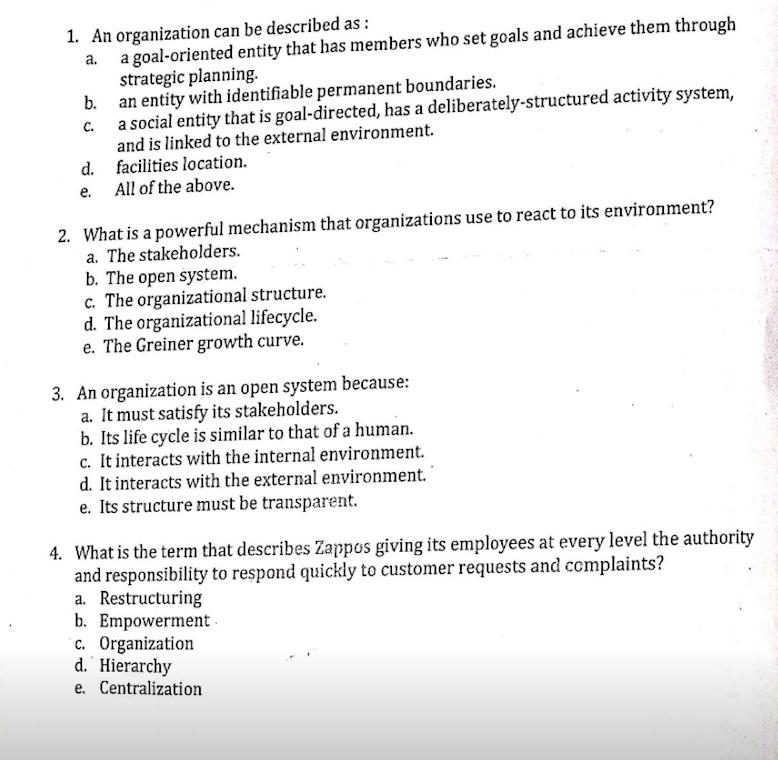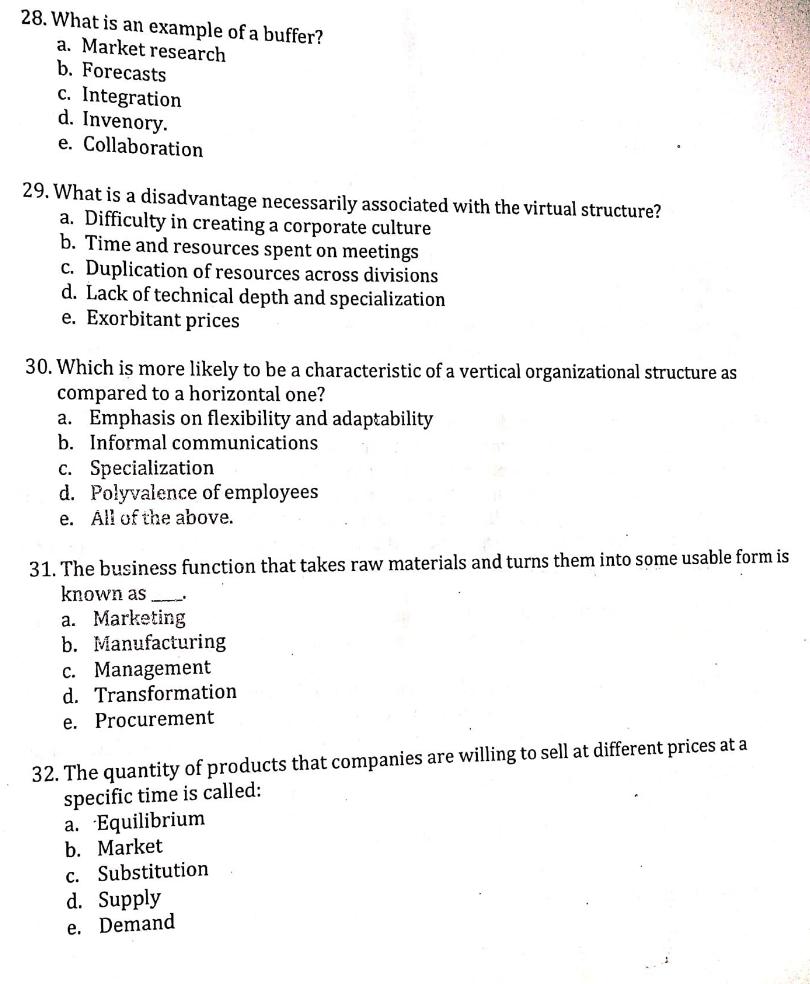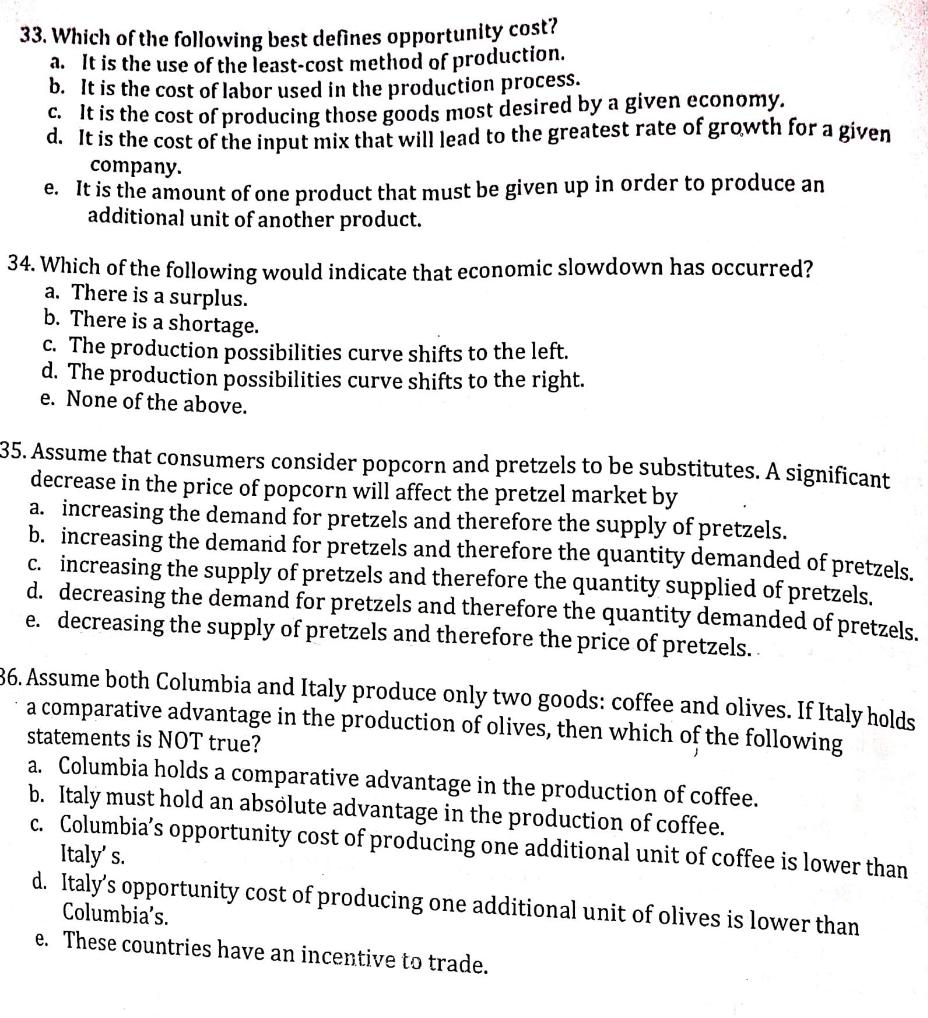Answered step by step
Verified Expert Solution
Question
1 Approved Answer
1. An organization can be described as: 1. An organization can be described as: a goal-oriented entity that has members who set goals and achieve
1. An organization can be described as: 




1. An organization can be described as: a goal-oriented entity that has members who set goals and achieve them through strategic planning. b. a. an entity with identifiable permanent boundaries. a social entity that is goal-directed, has a deliberately-structured activity system, and is linked to the external environment. facilities location. C. d. e. All of the above. 2. What is a powerful mechanism that organizations use to react to its environment? a. The stakeholders. b. The open system. c. The organizational structure. d. The organizational lifecycle. e. The Greiner growth curve. 3. An organization is an open system because: a. It must satisfy its stakeholders. b. Its life cycle is similar to that of a human. c. It interacts with the internal environment. d. It interacts with the external environment." e. Its structure must be transparent. 4. What is the term that describes Zappos giving its employees at every level the authority and responsibility to respond quickly to customer requests and ccmplaints? a. Restructuring b. Empowerment c. Organization d. Hierarchy e. Centralization 5. A visual drawing of the reporting relationships within an organization is called a(n): a. work specialization flow. b. organizational chart. C. division of labor schedule. d. unity of command chart. e. None of the above. 6. is the degree to which organizations standardize behavior through formal rules, procedures, training and related mechanisms throughout its different departments. a. Standardization b. Formalization c. Departmentalization d. Centralization e. Decentralization 7. Organizational structure refers to coordination and: a., Production. b. Allocation of resources. c. Decentralized decision-making. d. Division of labor. e. Strategic planning. 8. What is the technical term for the grouping together of departments that have similar organizational outputs? a. Staff structure b. Technical structure c. Divisional structure d. Vertical structure e. Horizontal structure 9. Which of the Greiner growth phases describes a period when the matrix organizational structure begins to be implemented at the company? a. Creativity b. Direction c. Delegation d. Collaboration e. None of the above 10. Productivity is a. The process of producing goods b. The amount of input you generate given the amount of output. c. The amount of output you generate given the amount of input. d. The act of transforming inputs to outputs. e. The efficient allocation of resources. 28. What is an example of a buffer? a. Market research b. Forecasts c. Integration d. Invenory. e. Collaboration 29. What is a disadvantage necessarily associated with the virtual structure? a. Difficulty in creating a corporate culture b. Time and resources spent on meetings c. Duplication of resources across divisions d. Lack of technical depth and specialization e. Exorbitant prices 30. Which is more likely to be a characteristic of a vertical organizational structure as compared to a horizontal one? a. Emphasis on flexibility and adaptability b. Informal communications c. Specialization d. Poyvalence of employees e. All of the above. 31. The business function that takes raw materials and turns them into some usable form is known as a. Marketing b. Manufacturing c. Management d. Transformation e. Procurement 32. The quantity of products that companies are willing to sell at different prices at a specific time is called: a. Equilibrium b. Market c. Substitution d. Supply e. Demand 23. Which corporate culture would best describe that of a luxury hotel such as The Ritz? a. Innovative culture b. People-oriented culture c. Team-oriented culture d. Detail-oriented culture e. Stable culture 24. The implementation of which type of organizational control requires the greatest amount of horizontal linkages? a. Task forces b. Teams c. Full-time integrators d. Information systems e. Buffering 25. The contextual dimension of an organization that is best identified by such influencing factors as the overall industry, government regulations, and the organization's supplie is recognized as a. The organization's technology b. The organization's culture c. The organization's strategic goals d. The organization's environment e. The organization's structure 26. Which structure is usually optimal for organizations with stable and predictable workloads, such as companies in the lumber industry? a. Functional b. Team C. Matrix d. Network e. Virtual 27. What does Greiner's growth model describe? a. The patterns that explain the birth and decline of organizations. b. The phases of growth of organizations, alternating between stability and crises. c. The different revolutions that an organization inevitably experiences. d. The growth and maturity of an organization in the digital age. e. The growth of an organization in three different phases: creativity, direction and delegation. 33. Which of the following best defines opportunity cost? a. It is the use of the least-cost method of production. b. It is the cost of labor used in the production process. C. It is the cost of producing those goods most desired by a given economy. d. It is the cost of the input mix that will lead to the greatest rate of growth for a given company. e. It is the amount of one product that must be given up in order to produce an additional unit of another product. 34. Which of the following would indicate that economic slowdown has occurred? a. There is a surplus. b. There is a shortage. c. The production possibilities curve shifts to the left. d. The production possibilities curve shifts to the right. e. None of the above. 35. Assume that consumers consider popcorn and pretzels to be substitutes. A significant decrease in the price of popcorn will affect the pretzel market by a. increasing the demand for pretzels and therefore the supply of pretzels. b. increasing the demand for pretzels and therefore the quantity demanded of pretzels. c. increasing the supply of pretzels and therefore the quantity supplied of pretzels. d. decreasing the demand for pretzels and therefore the quantity demanded of pretzels. e. decreasing the supply of pretzels and therefore the price of pretzels.. 36. Assume both Columbia and Italy produce only two goods: coffee and olives. If Italy holds a comparative advantage in the production of olives, then which of the following statements is NOT true? a. Columbia holds a comparative advantage in the production of coffee. b. Italy must hold an absolute advantage in the production of coffee. c. Columbia's opportunity cost of producing one additional unit of coffee is lower than Italy' s. d. Italy's opportunity cost of producing one additional unit of olives is lower than Columbia's. e. These countries have an incentive to trade.
Step by Step Solution
★★★★★
3.32 Rating (146 Votes )
There are 3 Steps involved in it
Step: 1
1An organization can be described as a a goal oriented entity that has members who set goals and achieve them through strategic planning 2Powerful mec...
Get Instant Access to Expert-Tailored Solutions
See step-by-step solutions with expert insights and AI powered tools for academic success
Step: 2

Step: 3

Ace Your Homework with AI
Get the answers you need in no time with our AI-driven, step-by-step assistance
Get Started


